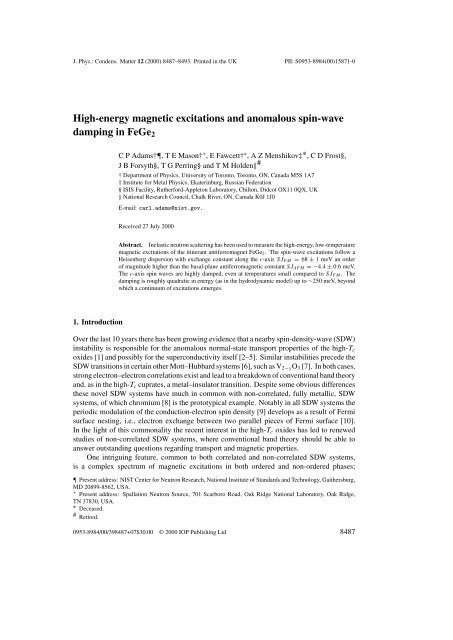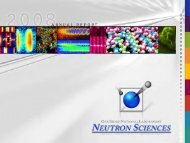ARCS materials - Spallation Neutron Source - Oak Ridge National ...
ARCS materials - Spallation Neutron Source - Oak Ridge National ...
ARCS materials - Spallation Neutron Source - Oak Ridge National ...
You also want an ePaper? Increase the reach of your titles
YUMPU automatically turns print PDFs into web optimized ePapers that Google loves.
J. Phys.: Condens. Matter 12 (2000) 8487–8493. Printed in the UK PII: S0953-8984(00)15871-0<br />
High-energy magnetic excitations and anomalous spin-wave<br />
damping in FeGe2<br />
1. Introduction<br />
C P Adams†, T E Mason† + , E Fawcett† ∗ , A Z Menshikov‡ ∗ , C D Frost§,<br />
J B Forsyth§, T G Perring§ and T M Holden #<br />
† Department of Physics, University of Toronto, Toronto, ON, Canada M5S 1A7<br />
‡ Institute for Metal Physics, Ekaterinburg, Russian Federation<br />
§ ISIS Facility, Rutherford-Appleton Laboratory, Chilton, Didcot OX11 0QX, UK<br />
<strong>National</strong> Research Council, Chalk River, ON, Canada K0J 1J0<br />
E-mail: carl.adams@nist.gov.<br />
Received 27 July 2000<br />
Abstract. Inelastic neutron scattering has been used to measure the high-energy, low-temperature<br />
magnetic excitations of the itinerant antiferromagnet FeGe2. The spin-wave excitations follow a<br />
Heisenberg dispersion with exchange constant along the c-axis SJFM = 68 ± 1 meV an order<br />
of magnitude higher than the basal-plane antiferromagnetic constant SJAF M =−4.4 ± 0.6 meV.<br />
The c-axis spin waves are highly damped, even at temperatures small compared to SJFM. The<br />
damping is roughly quadratic in energy (as in the hydrodynamic model) up to ∼250 meV, beyond<br />
which a continuum of excitations emerges.<br />
Over the last 10 years there has been growing evidence that a nearby spin-density-wave (SDW)<br />
instability is responsible for the anomalous normal-state transport properties of the high-Tc<br />
oxides [1] and possibly for the superconductivity itself [2–5]. Similar instabilities precede the<br />
SDW transitions in certain other Mott–Hubbard systems [6], such as V2−yO3 [7]. In both cases,<br />
strong electron–electron correlations exist and lead to a breakdown of conventional band theory<br />
and, as in the high-Tc cuprates, a metal–insulator transition. Despite some obvious differences<br />
these novel SDW systems have much in common with non-correlated, fully metallic, SDW<br />
systems, of which chromium [8] is the prototypical example. Notably in all SDW systems the<br />
periodic modulation of the conduction-electron spin density [9] develops as a result of Fermi<br />
surface nesting, i.e., electron exchange between two parallel pieces of Fermi surface [10].<br />
In the light of this commonality the recent interest in the high-Tc oxides has led to renewed<br />
studies of non-correlated SDW systems, where conventional band theory should be able to<br />
answer outstanding questions regarding transport and magnetic properties.<br />
One intriguing feature, common to both correlated and non-correlated SDW systems,<br />
is a complex spectrum of magnetic excitations in both ordered and non-ordered phases;<br />
Present address: NIST Center for <strong>Neutron</strong> Research, <strong>National</strong> Institute of Standards and Technology, Gaithersburg,<br />
MD 20899-8562, USA.<br />
+ Present address: <strong>Spallation</strong> <strong>Neutron</strong> <strong>Source</strong>, 701 Scarboro Road, <strong>Oak</strong> <strong>Ridge</strong> <strong>National</strong> Laboratory, <strong>Oak</strong> <strong>Ridge</strong>,<br />
TN 37830, USA.<br />
∗ Deceased.<br />
# Retired.<br />
0953-8984/00/398487+07$30.00 © 2000 IOP Publishing Ltd 8487

















